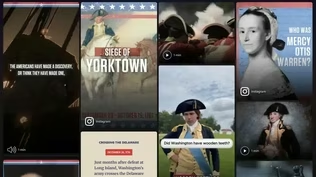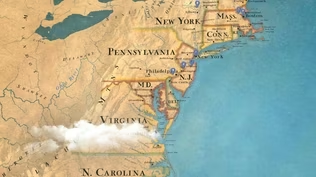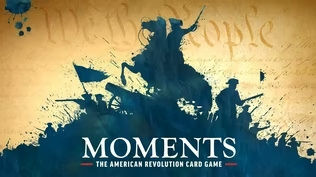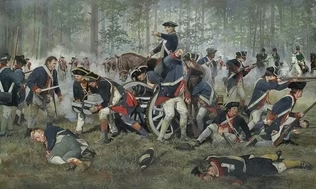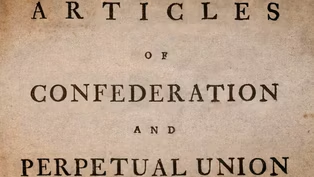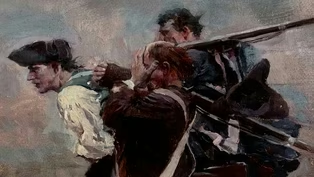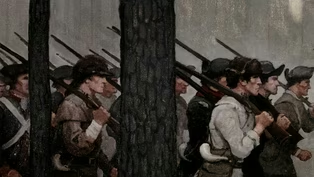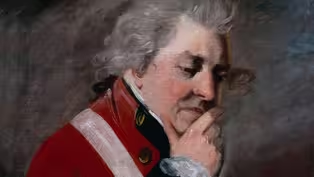
The Haudenosaunee Choose Sides in the American Revolution
Clip: Episode 4 | 8m 7sVideo has Closed Captions
The Six Nations of the Haudenosaunee choose opposing sides at the Battle of Oriskany.
The Haudenosaunee was a centuries-old union of the Six Nations: Seneca, Cayuga, Onondaga, Tuscarora, Oneida and Mohawk. But the confederacy is divided on their support of the American Revolution. The Oneidas support the Patriots, but some Mohawks led by Thayendanegea ally with the British. Things come to a head at the bloody Battle of Oriskany as Patriot, British and Native American forces clash.
Problems playing video? | Closed Captioning Feedback
Problems playing video? | Closed Captioning Feedback
Episodes presented in 4K UHD on supported devices. Corporate funding for THE AMERICAN REVOLUTION was provided by Bank of America. Major funding was provided by The Better Angels Society and...

The Haudenosaunee Choose Sides in the American Revolution
Clip: Episode 4 | 8m 7sVideo has Closed Captions
The Haudenosaunee was a centuries-old union of the Six Nations: Seneca, Cayuga, Onondaga, Tuscarora, Oneida and Mohawk. But the confederacy is divided on their support of the American Revolution. The Oneidas support the Patriots, but some Mohawks led by Thayendanegea ally with the British. Things come to a head at the bloody Battle of Oriskany as Patriot, British and Native American forces clash.
Problems playing video? | Closed Captioning Feedback
How to Watch The American Revolution
The American Revolution is available to stream on pbs.org and the free PBS App, available on iPhone, Apple TV, Android TV, Android smartphones, Amazon Fire TV, Amazon Fire Tablet, Roku, Samsung Smart TV, and Vizio.

MOMENTS: The Revolutionary War Card Game
Use your knowledge of Revolutionary-era moments to build a timeline of real historical events.Providing Support for PBS.org
Learn Moreabout PBS online sponsorship♪ Voice: We know the Indians now to have the highest notions of liberty of any people on Earth-- a people who will never consider consequences when they think their liberty likely to be invaded, though it may end in their ruin.
George Croghan.
Narrator: The Haudenosaunee was a centuries-old union comprised of the Six Nations-- Seneca, Cayuga, Onondaga, Tuscarora, Oneida, and Mohawk.
Each was allowed to act in its own interest, but they were expected to act together in matters affecting them all.
They likened their confederacy to a "great longhouse."
The Senecas were the keepers of its western door, the Mohawks--the eastern door.
At the center was Onondaga, where representatives met around the Great Council Fire.
Man: Normally you hammer things out until everybody says, "OK, this is what we will do."
And that had endured, right?
Battered and bruised and bombarded through colonial wars and all the rest of it.
That had endured.
And then the Revolution occurs.
[Cannon firing] Bonaparte: For us, the Mohawk people, it was survival.
Period.
And you didn't know which side was going to be the best choice.
We kind of gravitated mostly to the British because they had kind of won our respect, beating the French, and pretty much having our interests when they dealt with the regular colonists.
Voice: The disturbances in America give great trouble to all our nations.
The Mohawks, our particular nation, have on all occasions shown their zeal and loyalty to the Great King.
Thayendanegea.
Narrator: No Mohawk man identified more closely with the British than Thayendanegea, who was also known as Joseph Brant.
His sister Molly had married the British superintendent of Indian affairs, and her connections helped Brant make his name among the English.
He had fought for the Crown in the French and Indian War at 15, attended an English mission school, and, in 1776, traveled to London, where he reaffirmed his people's loyalty to Britain in an audience with King George III.
Many of the Indian people in this time are kind of anonymous to us in some ways because we don't have accurate representations of them, but one of the major exceptions is Joseph Brant, who had his portrait painted not once but many, many times.
This is the 18th century.
Not just anybody got their portrait painted.
To have your portrait painted multiple times was unusual.
I think he controlled his space.
"I confound your stereotypical images of savage Indians."
Narrator: Brant had fought against the Patriots at the Battle of Long Island, then began traveling from town to town within the Six Nations, urging the young men to join him.
It was imperative, he told them, to "defend" our "lands and liberty against the rebels "who, in a great measure, began the rebellion to be sole Masters of the Continent."
But suspicious of the way Brant seemed to move between the Indian and British worlds, more traditional leaders resented this minor chief's ambition to lead them into war, and preferred to hold back until it seemed clear Britain was headed for victory.
And so, when Brant assembled his armed Volunteers, only a handful were from the Six Nations.
Perhaps 80% of them were Loyalist settlers disguised as Indians.
♪ In early August, Brant's men were with British forces as they initiated the second part of Burgoyne's grand scheme to seize the Hudson and cut off the New England states.
They started by laying siege to Fort Stanwix, a Patriot outpost far west on the Mohawk River, a crucial meeting place that connected the Great Lakes with the East.
The British had believed the fort was only thinly defended and in disrepair.
Actually, it was held by some 600 Continental soldiers, and they had been strengthening the fortifications at the urging of some Oneidas, who made their homes in the valley and did not share Joseph Brant's enthusiasm for the Crown.
The American Revolution was about to plunge the once-united Six Nations into a civil war of their own.
Calloway: Many Oneidas were closer to the Americans.
Some are intermarried.
Oneida people were, in many cases, surrounded by American colonists.
Narrator: When an 800-man Patriot militia column commanded by General Nicholas Herkimer reached Oriska, an Oneida settlement on Oriskany Creek just eight miles from the embattled Fort Stanwix, sixty Oneida chiefs and warriors joined them.
They were ready to fight alongside their White neighbors and help thwart the British invasion.
Joseph Brant and his men were waiting for them, alongside hundreds of other Mohawks, Senecas, and Loyalists.
[Woman singing in Native American language on soundtrack] On the morning of August 6, 1777, as Herkimer's long column filed into a ravine and began splashing across a stream, Loyalists fired from above, while hundreds of Native Americans allied with the British ran down among the startled men, wielding tomahawks, clubs, and scalping knives.
♪ Bonaparte: It was a slaughter.
It was horrific what happened.
And even the Native people who survived the war said they'd never experienced anything like that.
♪ Narrator: Perhaps as many as 400 Patriot militia lay dead, including some 30 of their Oneida allies.
Almost 100 of the British forces had been killed or wounded, 65 of whom were Indians.
The Mohawks and Senecas were accustomed to warfare that yielded far fewer casualties, and were stunned.
Voice: There, I have seen the most dead bodies all over it that I never did see, and never will again.
I thought, at the time, the bloodshed a stream running down on the descending ground.
And yet some living crying for help, but have no mercy on to be spared of them.
Chainbreaker.
♪ Bonaparte: We look back on the Battle of Oriskany as one of those points where the Longhouse seemed to be burning-- the all-time worst-case scenario, where we're actually killing each other in combat.
For what?
For what?
For somebody else can claim our land?
Video has Closed Captions
Clip: Ep4 | 2m 14s | The Articles were weak by design and left Congress unable to pay soldiers in the Continental Army. (2m 14s)
Video has Closed Captions
Clip: Ep4 | 6m 18s | General Horatio Gates' force clashes with the British, beginning the Battle of Saratoga. (6m 18s)
The British Capture Philadelphia & The Battle of Germantown
Video has Closed Captions
Clip: Ep4 | 6m 29s | The British seize Philadelphia, but Washington plans to retake the city at the Battle of Germantown. (6m 29s)
Video has Closed Captions
Clip: Ep4 | 1m 9s | Artistic renderings of the Revolution often include the flag, but little is known about its origins. (1m 9s)
Patriot Victory at the Battle of Saratoga
Video has Closed Captions
Clip: Ep4 | 8m 59s | After days of fighting at Saratoga, Benedict Arnold and Horatio Gates secure a Patriot victory. (8m 59s)
Preview: Conquer by a Drawn Game
Video has Closed Captions
Preview: Ep4 | 30s | Philadelphia falls, but the American victory at Saratoga allows France to enter the war. (30s)
The Real People Who Fought the American Revolution
Video has Closed Captions
Clip: Ep4 | 4m 31s | Washington uses bonuses and drafts to encourage Americans to join the Continental Army. (4m 31s)
Religion & the Revolutionaries
Video has Closed Captions
Clip: Ep4 | 2m 5s | Most revolutionaries were Protestants, but there were also Catholics, Jews, and Muslims. (2m 5s)
Saratoga: A Psychological Turning Point
Video has Closed Captions
Clip: Ep4 | 33s | Historian Stephen Conway on the psychological impact of Saratoga on the British. (33s)
Turning the Tide in New Jersey
Video has Closed Captions
Clip: Ep4 | 59s | With Washington commanding less than 3,000, the winter of 1777 became a fight over supplies. (59s)
Providing Support for PBS.org
Learn Moreabout PBS online sponsorshipSupport for PBS provided by:
Episodes presented in 4K UHD on supported devices. Corporate funding for THE AMERICAN REVOLUTION was provided by Bank of America. Major funding was provided by The Better Angels Society and...

